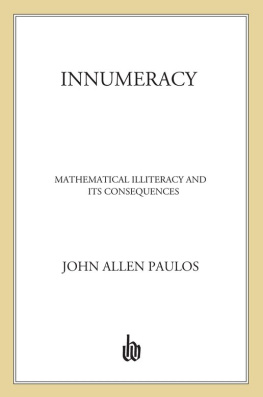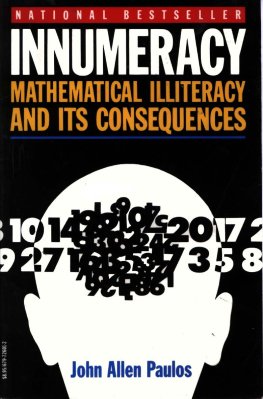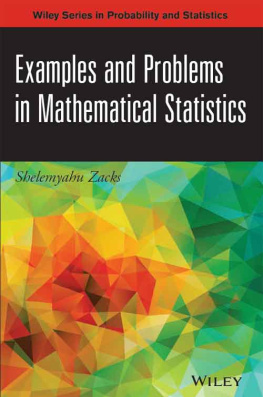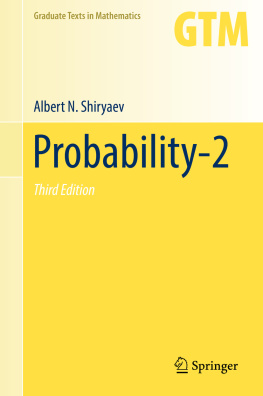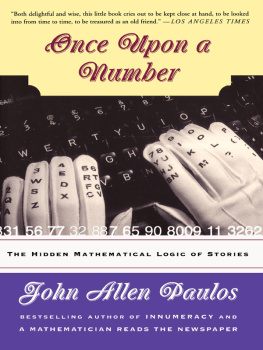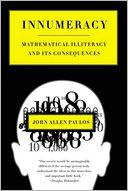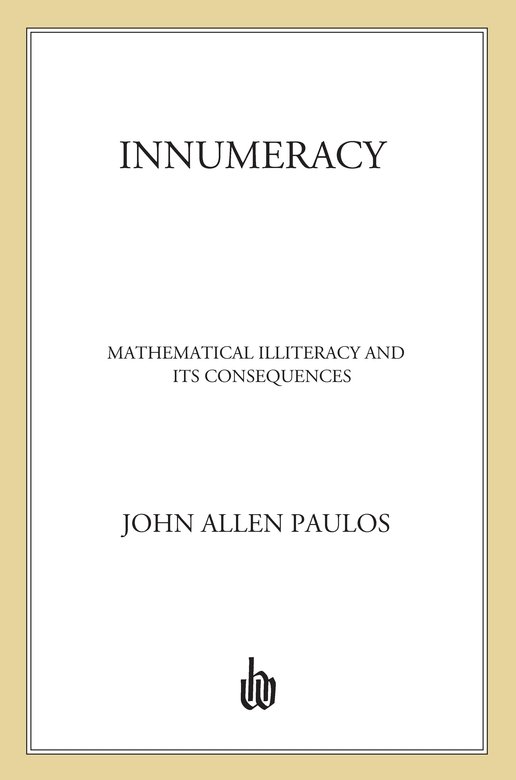John Allen Paulos, professor of mathematics at Temple University in Philadelphia, is the author of numerous books on mathematics, contributes regularly to such national publications as The New York Times, Newsweek , and The Nation , and writes the Whos Counting column for ABCNews.com . His Web page address is www.math.temple.edu/~paulos .
We sail within a vast sphere, ever drifting in uncertainty, driven from end to end.
Pascal
A man is a small thing, and the night is very large and full of wonders.
Lord Dunsany
Probability enters our lives in a number of different ways. The first route is often through randomizing devices such as dice, cards, and roulette wheels. Later we become aware that births, deaths, accidents, economic and even intimate transactions all admit of statistical descriptions. Next we cometo realize that any sufficiently complex phenomenon, even if its completely deterministic, will often be amenable only to probabilistic simulation. Finally, we learn from quantum mechanics that the most fundamental microphysical processes are probabilistic in nature.
Not surprisingly, then, an appreciation for probability takes a long time to develop. In fact, giving due weight to the fortuitous nature of the world is, I think, a mark of maturity and balance. Zealots, true believers, fanatics, and fundamentalists of all types seldom hold any truck with anything as wishy-washy as probability. May they all burn in hell for 1010 years (just kidding), or be forced to take a course in probability theory.
In an increasingly complex world full of senseless coincidence, whats required in many situations is not more factswere inundated alreadybut a better command of known facts, and for this a course in probability is invaluable. Statistical tests and confidence intervals, the difference between cause and correlation, conditional probability, independence, and the multiplication principle, the art of estimating and the design of experiments, the notion of expected value and of a probability distribution, as well as the most common examples and counter-examples of all of the above, should be much more widely known. Probability, like logic, is not just for mathematicians anymore. It permeates our lives.
At least part of the motivation for any book is anger, and this book is no exception. Im distressedby a society which depends so completely on mathematics and science and yet seems so indifferent to the innumeracy and scientific illiteracy of so many of its citizens; with a military that spends more than one quarter of a trillion dollars each year on ever smarter weapons for ever more poorly educated soldiers; and with the media, which invariably become obsessed with this hostage on an airliner, or that baby who has fallen into a well, and seem insufficiently passionate when it comes to addressing problems such as urban crime, environmental deterioration, or poverty.
Im pained as well at the sham romanticism inherent in the trite phrase coldly rational (as if warmly rational were some kind of oxymoron); at the rampant silliness of astrology, parapsychology, and other pseudosciences; and at the belief that mathematics is an esoteric discipline with little relation or connection to the real world.
Still, irritation with these matters was only part of my incentive. The discrepancies between our pretensions and reality are usually quite extensive, and since number and chance are among our ultimate reality principles, those who possess a keen grasp of these notions may see these discrepancies and incongruities with greater clarity and thus more easily become subject to feelings of absurdity. I think theres something of the divine in these feelings of our absurdity, and they should be cherished, not avoided. They provide perspective on our puny yet exalted position in the world, and are what distinguish us from rats. Anything which permanentlydulls us to them is to be opposed, innumeracy included. The desire to arouse a sense of numerical proportion and an appreciation for the irreducibly probabilistic nature of lifethis, rather than anger, was the primary motivation for the book.
Two aristocrats are out horseback riding and one challenges the other to see which can come up with the larger number. The second agrees to the contest, concentrates for a few minutes, and proudly announces, Three. The proposer of the game is quiet for half an hour, then finally shrugs and concedes defeat.
A summer visitor enters a hardware store in Maine and buys a large number of expensive items. The skeptical, reticent owner doesnt say a word as he adds the bill on the cash register. When hes finished,he points to the total and watches as the man counts out $1,528.47. He then methodically recounts the money once, twice, three times. The visitor finally asks if hes given him the right amount of money, to which the Mainer grudgingly responds, Just barely.
The mathematician G. H. Hardy was visiting his protg, the Indian mathematician Ramanujan, in the hospital. To make small talk, he remarked that 1729, the number of the taxi which had brought him, was a rather dull number, to which Ramanujan replied immediately, No, Hardy! No, Hardy! It is a very interesting number. It is the smallest number expressible as the sum of two cubes in two different ways.
Peoples facility with numbers ranges from the aristocratic to the Ramanujanian, but its an unfortunate fact that most are on the aristocrats side of our old Mainer. Im always amazed and depressed when I encounter students who have no idea what the population of the United States is, or the approximate distance from coast to coast, or roughly what percentage of the world is Chinese. I sometimes ask them as an exercise to estimate how fast human hair grows in miles per hour, or approximately how many people die on earth each day, or how many cigarettes are smoked annually in this country. Despite some initial reluctance (one student maintained that hair just doesnt grow in miles per hour),they often improve their feeling for numbers dramatically.
Without some appreciation of common large numbers, its impossible to react with the proper skepticism to terrifying reports that more than a million American kids are kidnapped each year, or with the proper sobriety to a warhead carrying a megaton of explosive powerthe equivalent of a million tons (or two billion pounds) of TNT.
And if you dont have some feeling for probabilities, automobile accidents might seem a relatively minor problem of local travel, whereas being killed by terrorists might seem to be a major risk when going overseas. As often observed, however, the 45,000 people killed annually on American roads are approximately equal in number to all American dead in the Vietnam War. On the other hand, the seventeen Americans killed by terrorists in 1985 were among the 28 million of us who traveled abroad that yearthats one chance in 1.6 million of becoming a victim. Compare that with these annual rates in the United States: one chance in 68,000 of choking to death; one chance in 75,000 of dying in a bicycle crash; one chance in 20,000 of drowning; and one chance in only 5,300 of dying in a car crash.
Confronted with these large numbers and with the correspondingly small probabilities associated with them, the innumerate will inevitably respond with the non sequitur, Yes, but what if youre that one, and then nod knowingly, as if theyve demolished your argument with their penetrating insight. This tendency to personalize is, as well see, a characteristic of many people who suffer from innumeracy.Equally typical is a tendency to equate the risk from some obscure and exotic malady with the chances of suffering from heart and circulatory disease, from which about 12,000 Americans die each week.

